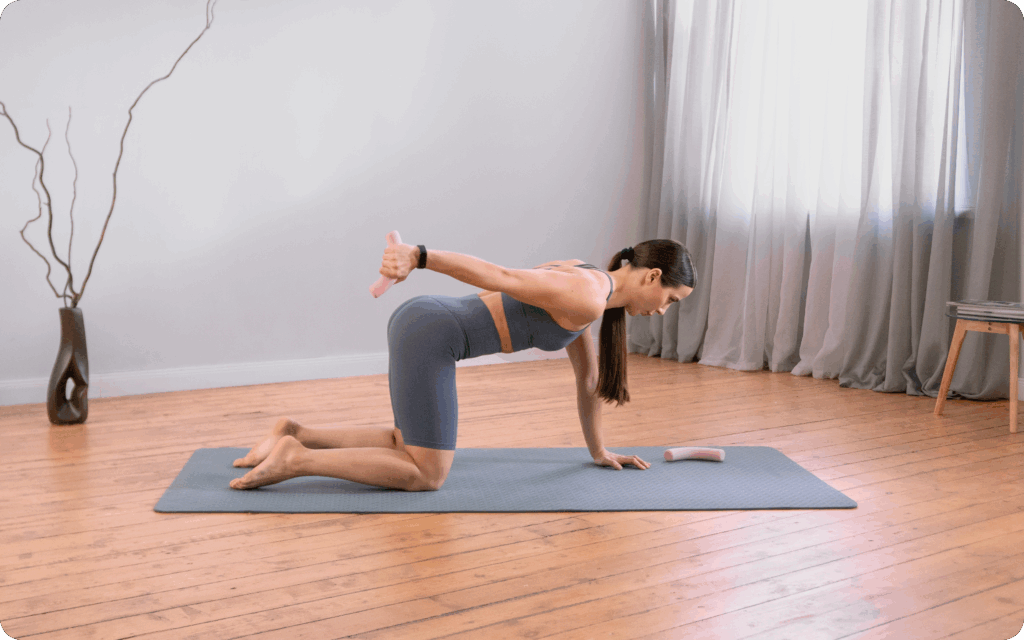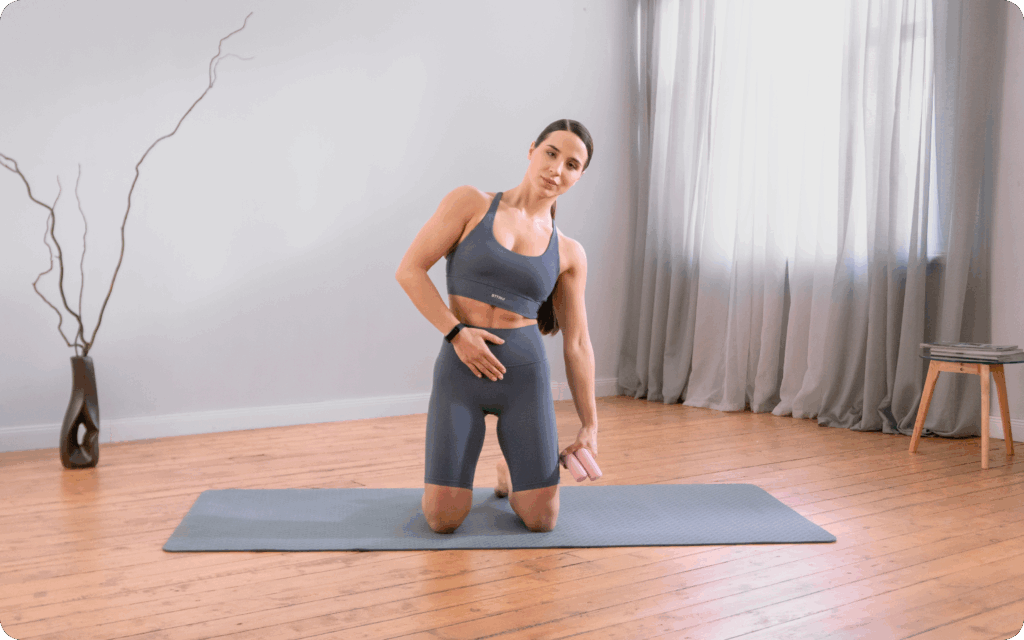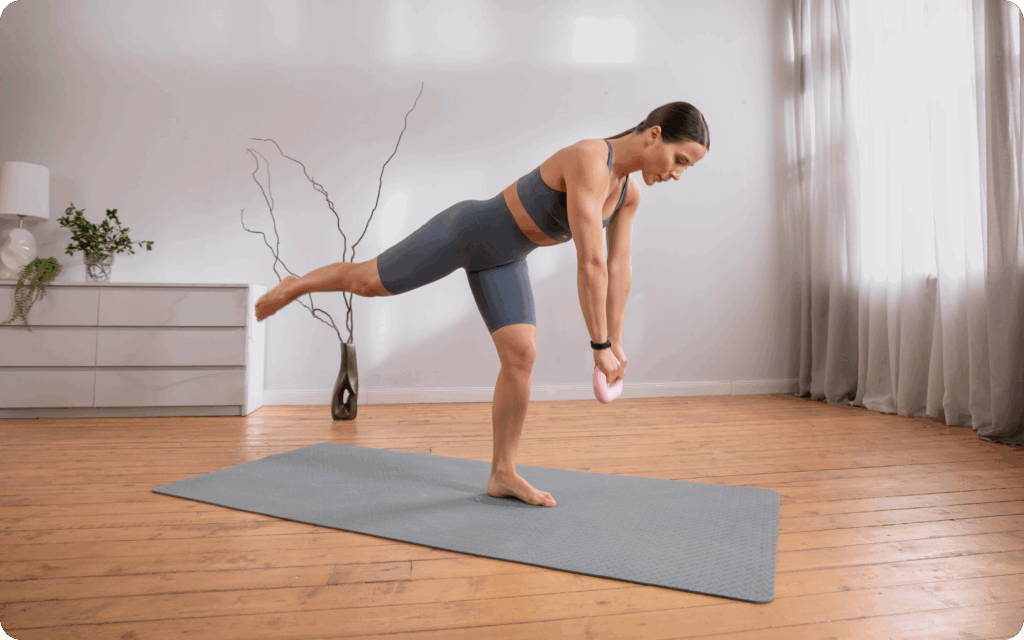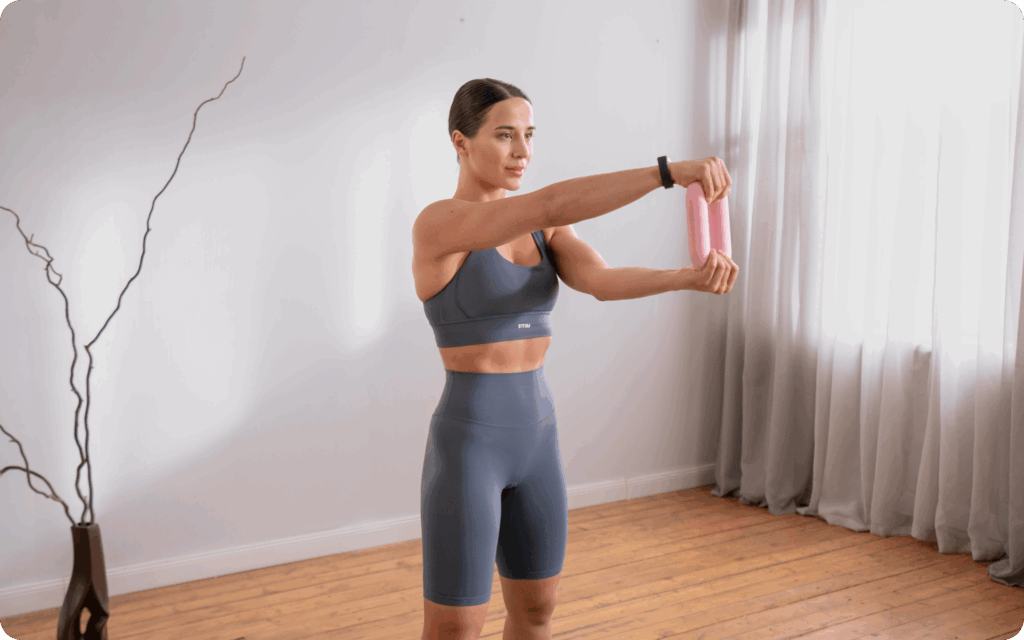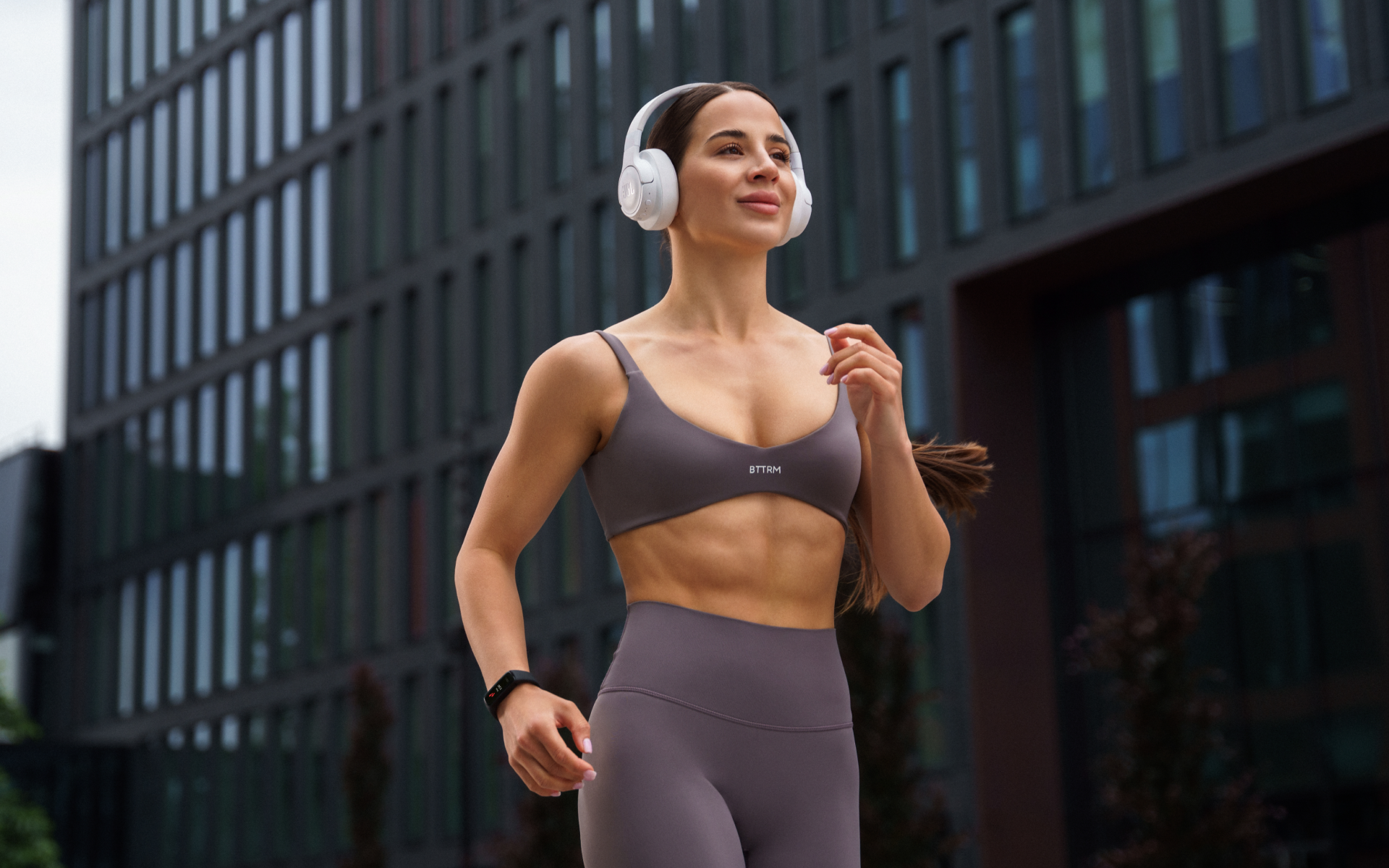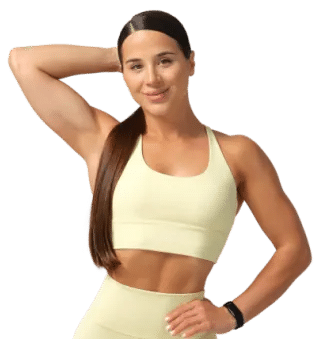Building muscle is a process that can be learned and achieved with the right plan. You don’t need a commercial gym membership or complex equipment to make significant progress. With a pair of dumbbells and a clear, evidence-based strategy, you can transform your physique from the comfort of your own home.
This guide will provide a structured 30-day muscle-building workout plan using only dumbbells. We’ll break down the science of muscle growth into practical, actionable steps, explaining not just what to do, but why it works. You will learn how to train, eat, and recover to maximize your results in one month.
Is It Possible to Build Muscle in 1 Month?
Yes, it’s absolutely possible to build a noticeable amount of muscle in one month, especially if you’re new to resistance training or returning after a break. The initial gains, often called “newbie gains”, are rapid because your body is highly responsive to the new stimulus of training.
For a beginner, three key ingredients are required:
- Consistent, progressive training: You must challenge your muscles regularly and increase that challenge over time (1).
- Sufficient nutrition: You need adequate protein and a slight calorie surplus to provide the building blocks and energy for muscle repair and growth (2).
- Adequate recovery: Muscle is built during rest, not during workouts. Prioritizing sleep is non-negotiable (3).
While a seasoned lifter’s progress will be slower, a focused 30-day period is still valuable for breaking through plateaus or adding new muscle mass by optimizing training variables. The key is to apply the correct principles with consistency.
Is It Actually Possible to Build Muscle at Home?
Building muscle at home is possible and can be just as effective as training in a gym. The principles of hypertrophy (muscle growth) are universal: you must create sufficient mechanical tension, metabolic stress, and muscle damage to signal your body to adapt and grow stronger (4). Your muscles cannot tell the difference between a dumbbell at home and a machine at the gym – they only respond to the stress that is placed upon them.
Dumbbells are a versatile tool for achieving this. They allow for a full range of motion, challenge stabilizing muscles, and can be used for a wide variety of exercises that target every major muscle group (5).
By focusing on proper form, progressive overload, and training with sufficient intensity, you can create a powerful muscle-building stimulus. This guide is built around one of the best workout routines for home-based training.
For more details about at-home workout plan without equipment, take a look at our prior publication.
Reasons why BetterMe is a safe bet: a wide range of calorie-blasting workouts, finger-licking recipes, 24/7 support, challenges that’ll keep you on your best game, and that just scratches the surface! Start using our app and watch the magic happen.
What Is a Solid 30-Day Muscle-Building Workout Plan at Home?
A solid plan is structured, progressive, and built on proven scientific principles. It should be more than just a list of exercises – it needs to specify the key variables that drive muscle growth.
Here are the core components of an effective 30-day muscle-building workout plan at home for beginners and intermediates alike:
- Training Frequency: The plan utilizes an upper/lower split, performed four days a week (e.g. Monday, Tuesday, Thursday, Friday). This means you train each muscle group twice per week, which research has suggested is optimal for balancing stimulus and recovery (6).
- Volume: The total number of hard sets per muscle group per week is the primary driver of hypertrophy. This plan starts with a moderate volume of 10-12 sets per major muscle group and progressively increases to 14-16 sets by the final week, which correlates with the optimal guidelines of 12-20 sets per week found in this study (7).
- Intensity and Effort: You will train close to muscular failure. We measure this with reps in reserve (RIR), which is how many more reps you could have done with good form. A 1-2 RIR means you stop the set when you feel you only have 1 or 2 perfect reps left in the tank. This ensures you’re recruiting the maximum number of muscle fibers (8).
- Progressive Overload: Each week, the plan incorporates a method to make the workouts more challenging. This could be adding weight, performing more reps with the same weight, or increasing the number of sets (1).
- Rest Periods: Recent meta-analyses confirm that longer rest periods are slightly superior for muscle growth. Resting for 60-90 seconds between sets allows your muscles to recover more fully, enabling you to lift heavier or perform more reps in subsequent sets, which increases the total volume load (9).
- Tempo: The speed of your reps matters. A controlled tempo, such as a 3-second lowering phase (eccentric), a brief pause, and a 1-second lifting phase (concentric), increases time under tension and improves mind-muscle connection. We will note this as (3-1-1-0) (10).
The 30-Day Dumbbell Workout Plan
This 30-day workout plan at home is structured as a 4-day upper/lower split.
- Day 1: Upper-Body A
- Day 2: Lower-Body A
- Day 3: Rest
- Day 4: Upper-Body B
- Day 5: Lower-Body B
- Day 6: Rest
- Day 7: Rest
Week 1: Foundation Phase
Focus on learning the movements and establishing a mind-muscle connection. Use a weight that allows you to hit the target rep range at a 2 RIR.
- Upper-Body A
- Dumbbell bench press: 3 sets of 8-12 reps (2 RIR) | 90s rest
- Bent-over dumbbell row: 3 sets of 8-12 reps (2 RIR) | 90s rest
- Dumbbell overhead press: 3 sets of 10-15 reps (2 RIR) | 90s rest
- Dumbbell bicep curls: 2 sets of 10-15 reps (1 RIR) | 60s rest
- Dumbbell triceps kickbacks: 2 sets of 10-15 reps (1 RIR) | 60s rest
- Lower-Body A
- Dumbbell goblet squats: 3 sets of 8-12 reps (2 RIR) | 90s rest
- Dumbbell Romanian deadlifts (RDLs): 3 sets of 10-15 reps (2 RIR) | 90s rest
- Dumbbell walking lunges: 2 sets of 10-12 reps per leg (2 RIR) | 90s rest
- Calf raises (holding dumbbells): 3 sets of 15-20 reps (1 RIR) | 60s rest
- Upper-Body B
- Incline dumbbell press: 3 sets of 8-12 reps (2 RIR) | 90s rest
- Single-arm dumbbell row: 3 sets of 8-12 reps per arm (2 RIR) | 90s rest
- Dumbbell lateral raises: 3 sets of 12-20 reps (1 RIR) | 60s rest
- Dumbbell hammer curls: 2 sets of 10-15 reps (1 RIR) | 60s rest
- Overhead triceps extensions: 2 sets of 10-15 reps (1 RIR) | 60s rest
- Lower-Body B
- Dumbbell split squats: 3 sets of 8-12 reps per leg (2 RIR) | 90s rest
- Dumbbell glute bridges: 3 sets of 12-15 reps (1 RIR) | 60s rest
- Dumbbell reverse lunges: 2 sets of 10-12 reps per leg (2 RIR) | 90s rest
- Calf raises (holding dumbbells): 3 sets of 15-20 reps (1 RIR) | 60s rest
Week 2: Progression Phase
Aim to increase the weight slightly on your compound lifts (the first two exercises of each day) while maintaining the same rep range and RIR. For other exercises, try to add 1-2 reps per set with the same weight.
- Upper-Body A: Add 1 set to bicep curls and triceps kickbacks (3 sets total each).
- Lower-Body A: Add 1 set to walking lunges (3 sets total).
- Upper-Body B: Add 1 set to hammer curls and overhead triceps extensions (3 sets total each).
- Lower-Body B: Add 1 set to reverse lunges (3 sets total).
Week 3: Intensity Phase
This week, we’ll increase the intensity by reducing the RIR. Push your sets closer to failure. Your goal is a 1 RIR on all exercises. If you hit the top of your rep range, increase the weight for the next set or session.
- All exercises: 3-4 sets, aim for 1 RIR.
- Maintain the same exercise structure as Week 2, but push harder on every set.
Week 4: Overload Phase
This is the peak week. We add both volume and intensity to create a powerful stimulus for growth. Your goal is to reach 0-1 RIR on the final set of each exercise.
- Upper-Body A
- Dumbbell bench press: 4 sets of 8-12 reps (1 RIR)
- Bent-over dumbbell row: 4 sets of 8-12 reps (1 RIR)
- Dumbbell overhead press: 4 sets of 10-15 reps (1 RIR)
- Dumbbell bicep curls: 3 sets of 10-15 reps (0-1 RIR)
- Dumbbell triceps kickbacks: 3 sets of 10-15 reps (0-1 RIR)
- Lower-Body A
- Dumbbell goblet squats: 4 sets of 8-12 reps (1 RIR)
- Dumbbell Romanian deadlifts (RDLs): 4 sets of 10-15 reps (1 RIR)
- Dumbbell walking lunges: 3 sets of 10-12 reps per leg (1 RIR)
- Calf raises (holding dumbbells): 4 sets of 15-20 reps (0-1 RIR)
- Upper-Body B
- Incline dumbbell press: 4 sets of 8-12 reps (1 RIR)
- Single-arm dumbbell row: 4 sets of 8-12 reps per arm (1 RIR)
- Dumbbell lateral raises: 4 sets of 12-20 reps (0-1 RIR)
- Dumbbell hammer curls: 3 sets of 10-15 reps (0-1 RIR)
- Overhead triceps extensions: 3 sets of 10-15 reps (0-1 RIR)
- Lower-Body B
- Dumbbell split squats: 4 sets of 8-12 reps per leg (1 RIR)
- Dumbbell glute bridges: 4 sets of 12-15 reps (0-1 RIR)
- Dumbbell reverse lunges: 3 sets of 10-12 reps per leg (1 RIR)
- Calf raises (holding dumbbells): 4 sets of 15-20 reps (0-1 RIR)
If you’re curious about the 4-day workout routine for beginners, check out our earlier article.
Read more: Weighted Pilates Workout: The Perfect Balance Of Strength And Flow
What Exercises Build Muscle the Fastest?
The exercises that build muscle the fastest are often compound movements that recruit multiple large muscle groups simultaneously. These movements allow you to lift the most weight, create the highest levels of mechanical tension, and trigger a robust hormonal response conducive to growth.
However, for complete development, it’s essential to include exercises that train muscles at long lengths, as emerging evidence has suggested that this can lead to superior hypertrophy.
Here are the top dumbbell exercises for building muscle:
- Dumbbell Goblet Squat / Split Squat: These are foundational for lower-body development, targeting the quads, glutes, and adductors. The split squat is particularly effective, as it trains each leg independently, correcting imbalances.
- Dumbbell Romanian Deadlift (RDL): This is the king of hamstring and glute development. It places the hamstrings under a significant stretch, which is a powerful stimulus for growth, especially in the distal (lower) part of the muscle.
- Dumbbell Bench Press (Flat and Incline): The flat press is a staple for overall chest, shoulder, and triceps mass. The incline variation emphasizes the clavicular (upper) fibers of the pec major, leading to a fuller-looking chest.
- Bent-Over Dumbbell Row: This movement is unparalleled for building a thick, dense back. It targets the lats, rhomboids, traps, and posterior deltoids. Performing it with a controlled form ensures maximum back engagement.
- Dumbbell Overhead Press: The primary builder for the deltoids, particularly the anterior (front) head. A strong overhead press contributes to broader-looking shoulders and is a true test of upper-body strength.
- Overhead Triceps Extension: This study found that exercises training the triceps with the arm overhead, which places the long head in a stretched position, are superior for growth compared to pushdowns or kickbacks. This is a must-do for complete arm development.
- Dumbbell Bicep Curls (Standard and Incline): While standard curls are effective, incline curls train the long head of the biceps at a greater muscle length, potentially leading to more comprehensive growth.
Dive deeper into the home workout plan with dumbbells with our dedicated article.
How Can I Speed up My Muscle Growth?
Beyond following a solid training plan, you can accelerate your progress by optimizing your nutrition and recovery. Think of these as muscle growth multipliers.
1. Optimize Your Nutrition
- Protein Intake: Protein provides the amino acids necessary for muscle repair and synthesis. A large body of evidence supports a daily intake of 1.6 to 2.2 grams of protein per kilogram of body weight (or about 0.7 to 1.0 grams per pound) (2). Distribute this evenly across 3-5 meals to keep muscle protein synthesis elevated throughout the day (11).
- Calorie Surplus: To build new tissue, you need a surplus of energy. Aim for a modest surplus of 5-15% above your total daily energy expenditure (TDEE), which translates to roughly 250-500 extra calories per day (12). This supports muscle gain while minimizing fat accumulation.
- Carbohydrate Intake: Carbohydrates are your body’s primary fuel source for high-intensity training. They also play a role in recovery by replenishing muscle glycogen. Aim for 6 to 12 grams of carbohydrates per kilogram of body weight per day, with a higher intake on training days (13).
- Nutrient Timing: While total daily intake is most important, consuming a protein and carbohydrate-rich meal 1-3 hours before and after your workout can enhance performance and kick-start the recovery process (14).
BetterMe: Health Coaching app is a foolproof way to go from zero to a weight loss hero in a safe and sustainable way! What are you waiting for? Start transforming your body now!
2. Prioritize Recovery
- Sleep: This is the most important and often neglected component of recovery. During deep sleep, your body releases growth hormones and focuses on tissue repair. Aim for 7 to 9 hours of quality, uninterrupted sleep per night. Consistently falling short will severely blunt your muscle-building potential (15).
- Active Recovery: On your rest days, light activity such as walking, stretching, or foam rolling may help with recovery (especially psychologically) without adding training stress (16).
A 30-day muscle-building workout plan at home no equipment could be a great complement on rest days.
- Stress Management: Chronic high stress elevates cortisol, a catabolic hormone that can break down muscle tissue and hinder recovery (17). Incorporate practices such as meditation, deep breathing, or simply spending time in nature to manage stress levels.
How Long Does It Realistically Take to Build Muscles?
The timeline for building muscle varies significantly based on genetics, training history, age, and the consistency of your efforts. It’s a marathon, not a sprint.
- Beginners (0-6 months of consistent training): This is the phase of most rapid progress. With an effective program, beginners often experience noticeable improvements in strength within the first few weeks, most notably due to neural adaptations in the muscles and not size difference 6-8 weeks (18).
- Intermediates (6 months to 2 years of training): As training experience increases, the rate of progress naturally slows. Intermediate lifters may notice gains occurring at a more gradual pace, with progress becoming less predictable and requiring more deliberate adjustments to training variables (18).
- Advanced (2+ years of consistent, strategic training): For advanced lifters, progress is achieved in smaller increments over extended periods. Even modest improvements in muscle size or strength represent significant achievements at this stage (18).
It’s essential to set realistic expectations. While a 30-day plan can produce visible results and build a strong foundation, lasting transformation is the result of months and years of consistent effort. Focus on the process of getting stronger and better with each workout, and the results will follow.
No. Research has consistently shown that muscle growth can be achieved across a wide spectrum of loads (19). You can build similar amounts of muscle by lifting light weights for 20-30 reps or heavy weights for 5-8 reps, as long as all sets are taken close to muscular failure (1-3 RIR). Lifting heavy is effective for building strength, but for pure muscle size, the key is high-effort training, regardless of the specific weight used (19). The calves and forearms are notoriously difficult to grow for many people. This is often attributed to a combination of factors: they have a higher proportion of slow-twitch muscle fibers (which have less growth potential than fast-twitch fibers), and they’re used to a high volume of daily, low-intensity work from walking (20). Building them often requires extremely high training volumes, a full range of motion, and a focus on the stretched position. For optimal muscle growth, the scientific consensus recommends a daily protein intake of 1.6 to 2.2 grams per kilogram of body weight (0.7-1.0 g/lb) (2). For a 180-pound (82 kg) individual, this is approximately 130-180 grams of protein per day. Spreading this intake across 3-5 meals helps maximize the muscle-building response. Sleep is essential for muscle growth because it is when the majority of repair and regeneration occurs. During deep sleep stages, the body releases a significant amount of human growth hormone (HGH), a key anabolic hormone (15). Lack of sleep (less than 7 hours per night) is shown to reduce HGH and testosterone levels, increase levels of the catabolic hormone cortisol, and impair muscle protein synthesis, which directly hinders your ability to build muscle (15).Frequently Asked Questions
Do you need to lift heavy to build muscle?
Which muscle is harder to grow?
How much protein do you need to build muscle?
How does sleep affect muscle growth?
The Bottom Line
A structured and scientific approach is your best tool for building muscle. This 30-day dumbbell plan provides the framework, but your consistency is what will ultimately forge the results.
Focus on mastering your form, pushing your effort, and fueling your body correctly. By committing to this process for the next 30 days, you’ll see physical changes and also build the sustainable habits that are required for long-term fitness success.
DISCLAIMER:
This article is intended for general informational purposes only and does not serve to address individual circumstances. It is not a substitute for professional advice or help and should not be relied on for making any kind of decision-making. Any action taken as a direct or indirect result of the information in this article is entirely at your own risk and is your sole responsibility.
BetterMe, its content staff, and its medical advisors accept no responsibility for inaccuracies, errors, misstatements, inconsistencies, or omissions and specifically disclaim any liability, loss or risk, personal, professional or otherwise, which may be incurred as a consequence, directly or indirectly, of the use and/or application of any content.
You should always seek the advice of your physician or other qualified health provider with any questions you may have regarding a medical condition or your specific situation. Never disregard professional medical advice or delay seeking it because of BetterMe content. If you suspect or think you may have a medical emergency, call your doctor.
SOURCES:
- Effects of Resistance Training Overload Progression Protocols on Strength and Muscle Mass (2024, pubmed.ncbi.nlm.nih.gov)
- Systematic review and meta-analysis of protein intake to support muscle mass and function in healthy adults (2022, pubmed.ncbi.nlm.nih.gov)
- The Importance of Recovery in Resistance Training Microcycle Construction (2024, pmc.ncbi.nlm.nih.gov)
- Anabolic signals and muscle hypertrophy – Significance for strength training in sports medicine (2025, sciencedirect.com)
- The Effect of the Weight and Type of Equipment on Shoulder and Back Muscle Activity in Surface Electromyography during the Overhead Press—Preliminary Report (2022, mdpi.com)
- Effects of Resistance Training Frequency on Measures of Muscle Hypertrophy: A Systematic Review and Meta-Analysis (2016, link.springer.com)
- A Systematic Review of The Effects of Different Resistance Training Volumes on Muscle Hypertrophy (2022, pmc.ncbi.nlm.nih.gov)
- Application of the Repetitions in Reserve-Based Rating of Perceived Exertion Scale for Resistance Training (2016, pmc.ncbi.nlm.nih.gov)
- Give it a rest: a systematic review with Bayesian meta-analysis on the effect of inter-set rest interval duration on muscle hypertrophy (2024, frontiersin.org)
- The Influence of Movement Tempo During Resistance Training on Muscular Strength and Hypertrophy Responses: A Review (2022, link.springer.com)
- Evenly Distributed Protein Intake over 3 Meals Augments Resistance Exercise–Induced Muscle Hypertrophy in Healthy Young Men (2020, sciencedirect.com)
- How Many Calories Do You Need to Build Muscle? (2022, americansportandfitness.com)
- The Importance of Carbohydrate Intake for Maintaining Glycogen Stores and Physical Performance during Prolonged Exercise : A Literature Review (2024, researchgate.net)
- Nutrient Timing: A Garage Door of Opportunity? (2020, mdpi.com)
- Sleep and muscle recovery: Endocrinological and molecular basis for a new and promising hypothesis (2011, sciencedirect.com)
- A Systematic Review on the Effectiveness of Active Recovery Interventions on Athletic Performance of Professional-, Collegiate-, and Competitive-Level Adult Athletes (2019, journals.lww.com)
- Stress effects on the body (2024, apa.org)
- Neuromuscular adaptations to resistance training in elite versus recreational athletes (2025, frontiersin.org)
- Resistance Training Load Effects on Muscle Hypertrophy and Strength Gain: Systematic Review and Network Meta-analysis (2020, pmc.ncbi.nlm.nih.gov)
- Do the anatomical and physiological properties of a muscle determine its adaptive response to different loading protocols? (2020, pmc.ncbi.nlm.nih.gov)


